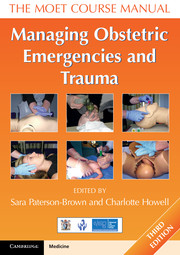Book contents
- Frontmatter
- Dedication
- Contents
- Working Group
- About the authors
- Acknowledgements
- Abbreviations
- Section 1 Introduction
- Section 2 Recognition
- Section 3 Resuscitation
- Section 4 Trauma
- Section 5 Other medical and surgical emergencies
- Section 6 Obstetric emergencies
- 24 Pre-eclampsia and eclampsia
- 25 Major obstetric haemorrhage
- 26 Caesarean section
- 27 Placenta accreta and retained placenta
- 28 Uterine inversion
- 29 Ruptured uterus
- 30 Ventouse and forceps delivery
- 31 Shoulder dystocia
- 32 Umbilical cord prolapse
- 33 Face presentation
- 34 Breech delivery and external cephalic version
- 35 Twin pregnancy
- 36 Complex perineal and anal sphincter trauma
- 37 Symphysiotomy and destructive procedures
- 38 Anaesthetic complications in obstetrics
- Section 7 Triage and transfer
- Section 8 Human issues
- Index
32 - Umbilical cord prolapse
- Frontmatter
- Dedication
- Contents
- Working Group
- About the authors
- Acknowledgements
- Abbreviations
- Section 1 Introduction
- Section 2 Recognition
- Section 3 Resuscitation
- Section 4 Trauma
- Section 5 Other medical and surgical emergencies
- Section 6 Obstetric emergencies
- 24 Pre-eclampsia and eclampsia
- 25 Major obstetric haemorrhage
- 26 Caesarean section
- 27 Placenta accreta and retained placenta
- 28 Uterine inversion
- 29 Ruptured uterus
- 30 Ventouse and forceps delivery
- 31 Shoulder dystocia
- 32 Umbilical cord prolapse
- 33 Face presentation
- 34 Breech delivery and external cephalic version
- 35 Twin pregnancy
- 36 Complex perineal and anal sphincter trauma
- 37 Symphysiotomy and destructive procedures
- 38 Anaesthetic complications in obstetrics
- Section 7 Triage and transfer
- Section 8 Human issues
- Index
Summary
Objectives
On successfully completing this topic, you will be able to:
safely and efficiently manage prolapse of the umbilical cord to improve perinatal out come whilst minimising maternal risk.
Introduction
Definition and incidence
Cord prolapse occurs when a loop of umbilical cord descends below the presenting part and the membranes are ruptured. Umbilical cord prolapse occurs in approximately 0.2% of all births.
A high percentage of mothers are multiparous. The incidence of prolapsed cord was 0.6% of all births in 1932. The reduction in frequency of the complication probably reflects reduct ion in family size, as well as changes in obstetric practice. These include the increased use of elective and intrapartum CS for a noncephalic, or an unengaged, presenting part and a more active approach to intrapartum management of the very preterm fetus.
Significance
In cord prolapse, the fetal perinatal mortality has been as high as 25–50% from asphyxia due to:
• mechanical compression of the cord between the presenting part and bony pelvis
• spasm of the cord vessels when exposed to cold or manipulations.
The perinatal mortality rate associated with umbilical cord prolapse has also fallen. One recent large study found a perinatal mortality rate of 91/1000. The cause of death for infants born after umbilical cord prolapse now seems to be related more to the complications of prematurity, associated congenital malformations and low birthweight, than to intrapartum asphyxia as such.
- Type
- Chapter
- Information
- Managing Obstetric Emergencies and TraumaThe MOET Course Manual, pp. 383 - 388Publisher: Cambridge University PressPrint publication year: 2014

